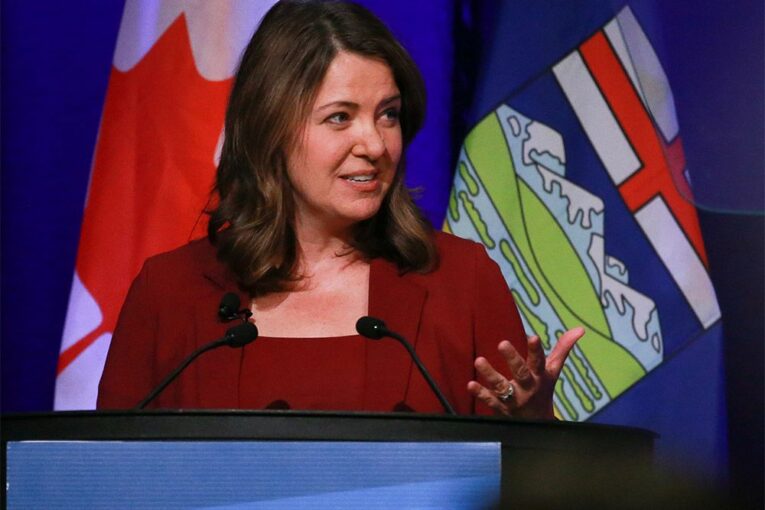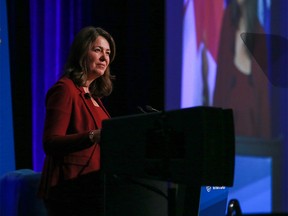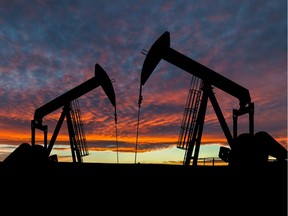
Alberta’s budget math is a pretty simple equation these days, even for those of us who can’t get the tap function on their debit card to work.
Take record oil and gas revenues and add in record income taxes.
Voila, record budget surplus.
That is the basic arithmetic behind Alberta’s year-end financial numbers, released Thursday, for the fiscal 12-month period that ended in March.
With total government revenues coming in at $76 billion and expenses at $64.5 billion, the surplus reached a staggering $11.6 billion.
It’s the highest on record and easily bests the back-to-back $8.5-billion surpluses reported in 2005 and 2006.
Last year, thanks to record oil production and crude prices clocking in almost $20-a-barrel above initial budget projections — averaging nearly US$90 per barrel — the province’s non-renewable resource revenue topped $25 billion.
That’s not a misprint.
That figure was 82 per cent higher than initially forecast when the provincial budget came out last year.
Speaking to a Calgary Chamber of Commerce luncheon on Thursday, Premier Danielle Smith said high energy prices left the province on a strong footing, but also pointed to the record $8.2 billion in corporate income taxes that were collected.
That’s more than 100 per cent above budget expectations.
Personal income taxes were also about $500 million above budget to reach $13.9 billion as more Albertans were working and people moved into the province.
Recommended from Editorial
-

Alberta posts historically high $11.6B surplus in 2022, powered by oil revenues
-

Corporate income tax just one part of economic growth equation
-

Varcoe: Oil and gas production tumbles in a net-zero future, Canada Energy Regulator report shows
But you can’t overlook the sheer impact of the royalty roller-coaster reaching light speed as oil markets took off, with prices briefly exceeding $120 a barrel last summer.
“It could be that for the next several years we have a higher level of resource revenues. And it could be that we have a higher level of production. I’m hoping it is,” Smith told reporters after the speech.
“But we want to make sure that we don’t do the same thing of increasing our spending to the level of the royalties coming in.”
Along with a growing economy and a surging population, the pressure will mount to raise spending, as more people require more health care, education and other essential services.
What’s easy to forget is this historic surplus arrived only two years after the province reported nearly $17 billion in red ink during the first full year of the pandemic.
“Relative to 2021, it’s the largest improvement in a provincial budget balance in Canadian history,” said University of Calgary economist Trevor Tombe.
“This is definitely remarkable, but the reason is also quite clear.”

The roundup of the last budget year is also a bit like looking out the rear-view mirror. What’s more important is the road ahead.
The biggest speed bumps are tied to volatile global energy markets and continuing concerns about a global economic slowdown. Stubbornly high inflation is triggering additional interest rate hikes, which could choke off energy demand.
Benchmark West Texas Intermediate crude prices traded just under $70 a barrel on Thursday afternoon, well below the current budget projection of $79 a barrel made in February’s budget.
With the new budget forecasting a smaller $2.4-billion surplus this year, and the UCP making a $1-billion campaign promise this spring to establish a lower income tax bracket, things could get tight in the months ahead.
Tombe estimates the revenue gap today, from the February budget, could be about $1.6 billion, based on current commodity prices.
With about three-quarters of all oilsands production in the province now paying royalties at a higher “post-payout” rate, and bitumen production rising, the province is also more tied to the volatility that comes from unpredictable commodity prices.
“The sensitivity of this revenue source to oil price changes is now double the historical norm since 2000. And that will only increase from here,” Tombe said.
Firms such as Goldman Sachs and JPMorgan Chase & Co. have trimmed their oil price outlook in the past month.
However, not everyone is quite so bearish.
A report released Wednesday by energy analytics firm Enverus said the “clock is ticking” on oil heading back to $100 a barrel.

It noted rising global oil demand, ongoing intervention by OPEC to protect prices and a lack of sufficient growth in North American production are pushing Brent crude prices to reach $100 a barrel during the final three months of this year.
“As the year progresses, demand accelerates and OPEC (output) stays flat, we get to a point where the market is extremely tight,” Enverus senior vice-president Al Salazar said in an interview.
“If that imbalance continues into the fourth quarter, it’s $100 territory.”
A new forecast by TD Economics expects the provincial economy will grow by 2.7 per cent, the highest level in the country, powered by job creation, rapid population growth and increasing oil output.
Smith pointed out a narrowing in the price discount facing Western Canadian Select heavy crude, and the state of the Canadian dollar, are giving the government confidence it can meet its budget targets.
She also noted the government adopted a new fiscal framework, which includes allocating at least 50 per cent of all surplus cash to paying down maturing debt, increasing its savings and keeping operational spending increases below the rate of inflation plus population growth.
“We’re going to continue to invest investment income in the Heritage Savings Trust Fund. I’d love to grow that to $200 billion,” Smith added.
“If you can forecast out 10, 20 or 30 years, being able to have that long-term revenue source is how we’re going to wean ourselves off the roller-coaster. It all takes time.”
Chris Varcoe is a Calgary Herald columnist.
You can read more of the news on source
